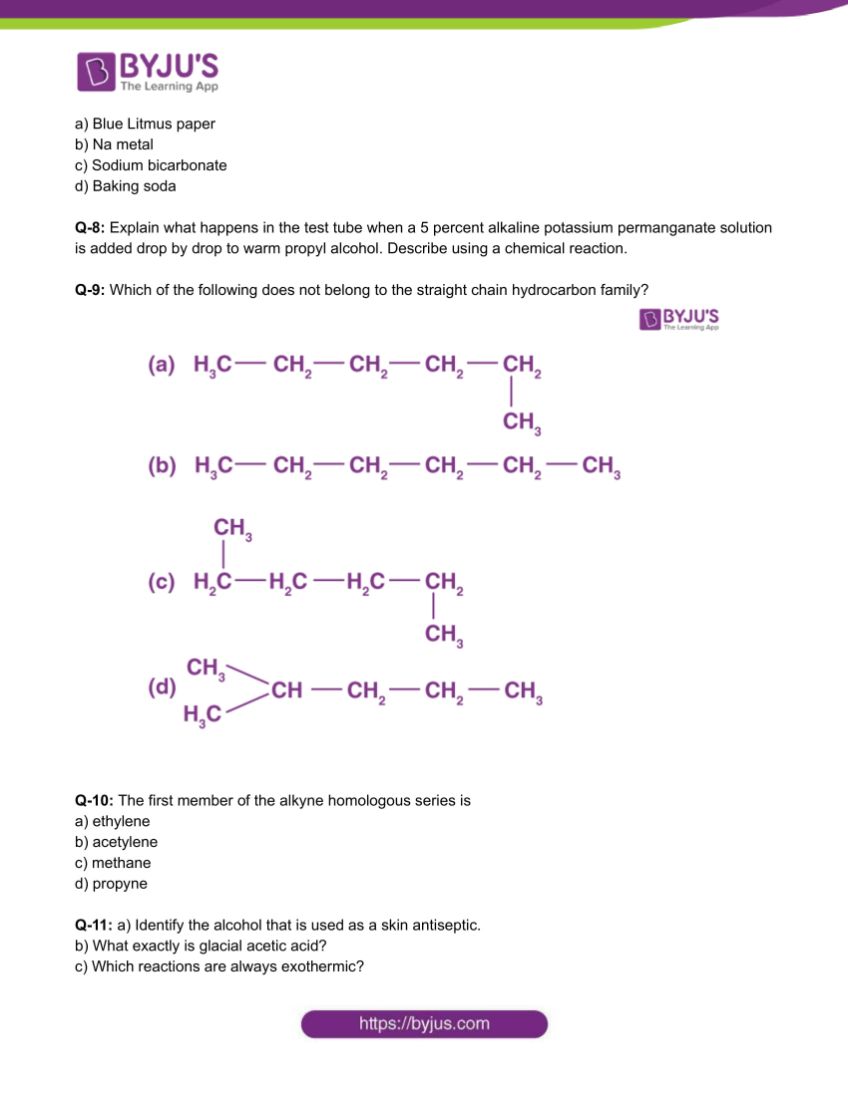Carbon compounds can be found in everything, including the food we eat, the clothes we wear, and even the lead of the pencil we use to write. It is the seventeenth most abundant element on the planet, according to data. It exists in both the free and combined states.
Download Class 10 Chemistry Worksheet on Chapter 4 Carbon and Its compounds Set 3 PDF
CBSE Class 10 Chemistry Chapter 4 Carbon and its Compounds – Set 3
Q-1: Identify the unsaturated compounds in the following
a) Chloroprene
b) Butyne
c) Iodopropane
d) Ethane
Q-2: Which of the following hydrocarbons undergo addition reactions?
C2H6, C3H8, C2H2, C2H4, C4H10, C4H8, C3H4
Q-3: Which of the following is the electron dot structure of the N2O molecule?

Q-4: Carbon, (Group 14) in the periodic table, is known to form compounds with a wide range of elements. Give an example of a compound that was formed with
a) Chlorine (Group 17 of periodic table)
b) Sulphur ( group 16 of periodic table)
Q-5: How would you name the following compounds?

Q-6: Give reasons why:
a) Despite the fact that candle wax is composed of saturated hydrocarbons, it produces a yellow luminous flame.
b) Cooking oil decolorizes bromine water but not kerosene oil.
Q-7: Which of the following can be used to test the acidic nature of ethanol?
a) Blue Litmus paper
b) Na metal
c) Sodium bicarbonate
d) Baking soda
Q-8: Explain what happens in the test tube when a 5 percent alkaline potassium permanganate solution is added drop by drop to warm propyl alcohol. Describe using a chemical reaction.
Q-9: Which of the following does not belong to the straight chain hydrocarbon family?

Q-10: The first member of the alkyne homologous series is
a) ethylene
b) acetylene
c) methane
d) propyne
Q-11: a) Identify the alcohol that is used as a skin antiseptic.
b) What exactly is glacial acetic acid?
c) Which reactions are always exothermic?
Q-12: List the products of coal and petroleum combustion. Give an explanation for why they should be used sparingly.
Q-13: The structural formula for an ester is

Write the formula of the acid and the alcohol from which it is made.
Statements for the linked answer questions 14-17
Cleaning agents include soaps and detergents. Because most dirt is oily in nature, it does not dissolve in water. Soaps are long chain carboxylic acid sodium or potassium salts. Water dissolves the hydrophilic end, while oil dissolves the hydrophobic end. As a result, the soap molecules form micelles, which are attracted by both dirt and water. When washing clothes in hard water, some of the soap precipitates and sticks to the fabric as scum. Detergents are used to avoid this problem.
Q-14: Name the three fatty acids whose sodium or potassium salts are present in soap.
Q-15: What is scum? How is it formed?
Q-16: Why does hard water not produce foam easily with soap?.
Q-17: A soft water sample can be distinguished from hard water using
a) a detergent solution
b) sodium bicarbonate solution
c) Red litmus solution
d) soap solution
Q-18: Match the column I with column II

Q-19: a) Define the term isomer.
b) Two compounds have the same molecular formula C3H6O. Write the names of these compounds and their structural formula.
Q-20: Based on the diagram below, answer the following questions:

a)What changes do you notice in tube B’s calcium hydroxide solution?
b) What are the results of the reactions in test tubes A and B?
c) Would you expect the same effect if ethanol instead of ethanoic acid was used?
d) How do you make a laboratory solution of lime water?
Download the PDF to access answers to the Chemistry Worksheet for Class 10 Chemistry Chapter 4 Carbon and Its compounds Set – 3
Download PDF
Read Also:
- Carbon and its Compounds
- Carbon Compounds
- Carbon and its Compounds Questions
- Carbon(C)
- Class 10 Carbon and Its compounds MCQ
- Class 10 Carbon and its Compounds Important Questions with Answers
Recommended Videos
Carbon and its Compounds| Class 10 Science






